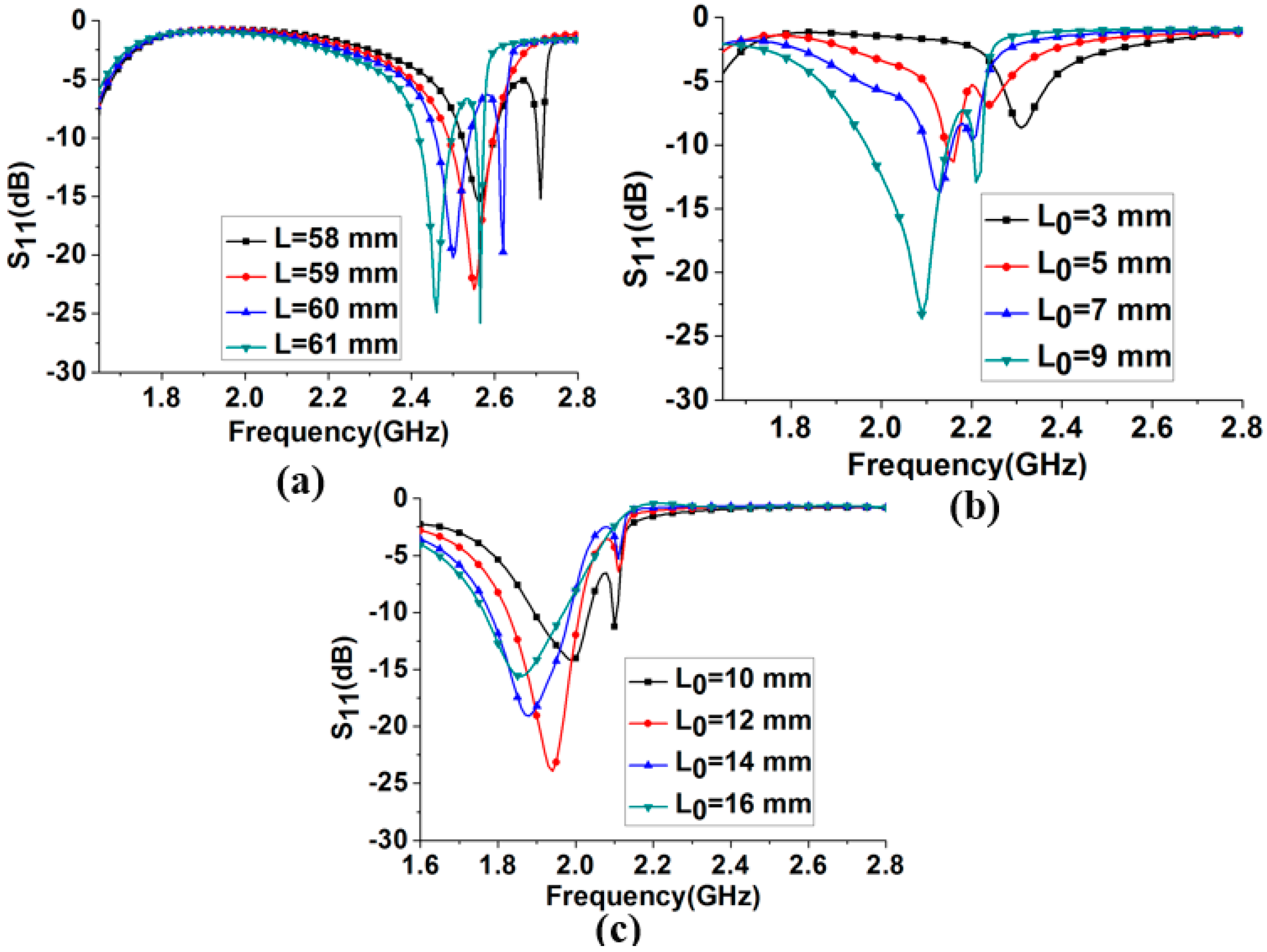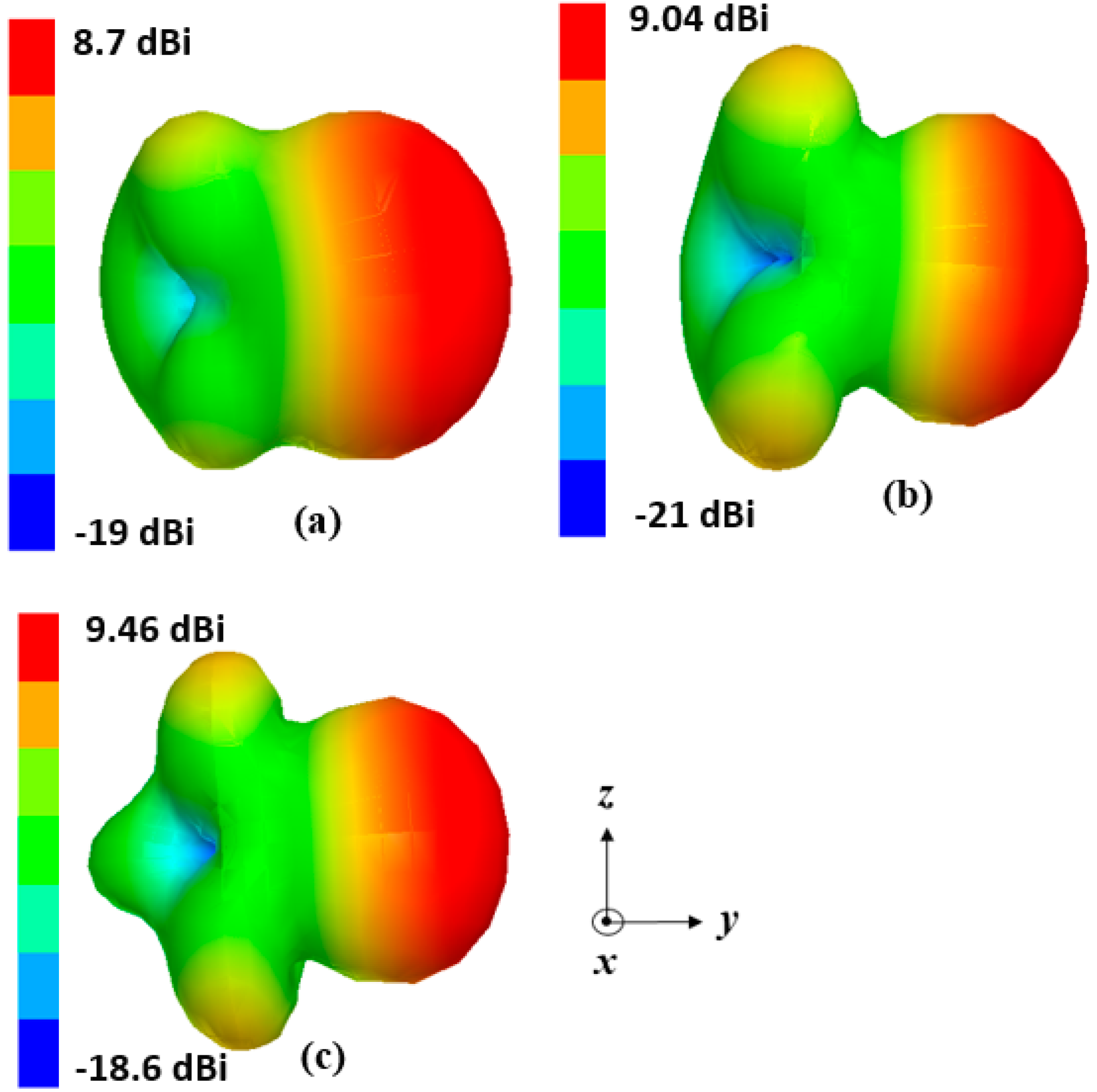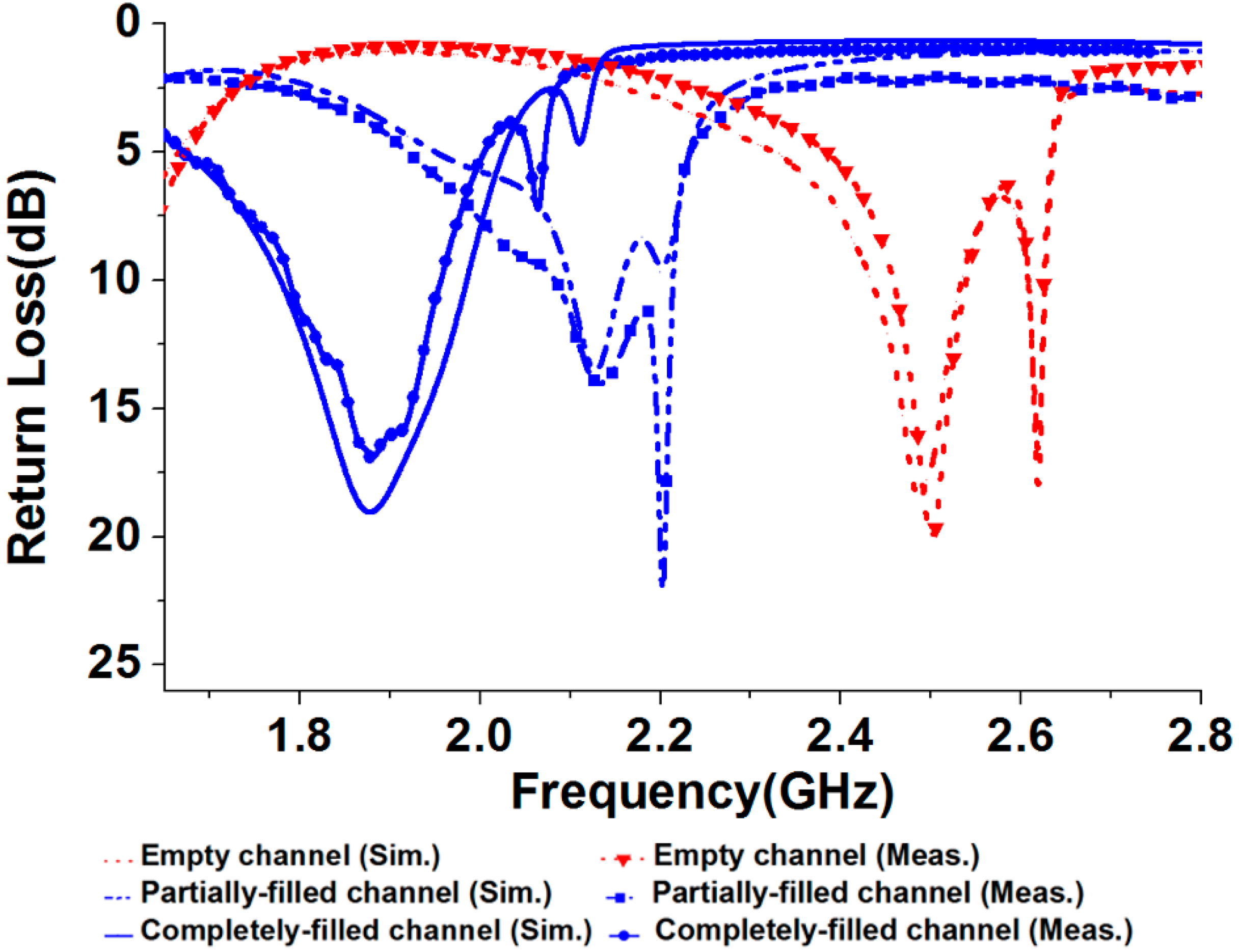Microfluidically Frequency-Reconfigurable Quasi-Yagi Dipole Antenna
Abstract
:1. Introduction
2. Antenna Design
3. Experimental Verification
4. Conclusions
Author Contributions
Funding
Conflicts of Interest
References
- DeJean, G.R.; Tentzeris, M.M. A new high-gain microstrip Yagi array antenna with a high front-to-back (F/B) ratio for WLAN and millimeter-wave applications. IEEE Trans. Antennas Propag. 2007, 55, 298–304. [Google Scholar] [CrossRef]
- Lim, S.; Ling, H. Design of a Closely Spaced, Folded Yagi Antenna. IEEE Antennas Wirel. Propag. Lett. 2006, 5, 302–305. [Google Scholar] [CrossRef]
- Huang, J. Microstrip Yagi Array Antenna for Mobile Satellite Vehicle Application. IEEE Trans. Antennas Propag. 1991, 7, 1024–1030. [Google Scholar] [CrossRef]
- Sedighy, S.H.; Mallahzadeh, A.R.; Soleimani, M.; Rashed-Mohassel, J. Optimization of printed yagi antenna using invasive weed optimization (IWO). IEEE Antennas Wirel. Propag. Lett. 2010, 9, 1275–1278. [Google Scholar] [CrossRef]
- Kramer, O.; Djerafi, T.; Wu, K. Vertically multilayer-stacked yagi antenna with single and dual polarizations. IEEE Trans. Antennas Propag. 2010, 58, 1022–1030. [Google Scholar] [CrossRef]
- Wu, J.; Zhao, Z.; Nie, Z.; Liu, Q.H. Bandwidth enhancement of a planar printed Quasi-Yagi antenna with size reduction. IEEE Trans. Antennas Propag. 2014, 62, 463–470. [Google Scholar] [CrossRef]
- Boukarkar, A.; Lin, X.Q.; Member, S.; Jiang, Y. A Dual-Band Frequency-Tunable Magnetic Dipole Antenna for WiMAX / WLAN Applications. IEEE Antennas Wirel. Propag. Lett. 2016, 15, 492–495. [Google Scholar] [CrossRef]
- Peroulis, D.; Sarabandi, K.; Katehi, L.P.B. Design of reconfigurable slot antennas. IEEE Trans. Antennas Propag. 2005, 53, 645–654. [Google Scholar] [CrossRef] [Green Version]
- Wang, Y.; Yoon, K.-C.; Lee, J.C. A Frequency Tunable Double Band-Stop Resonator (BSR) with Voltage Control by Varactor Diodes. J. Electr. Eng. Sci. 2016, 16, 159–163. [Google Scholar] [CrossRef]
- Jiang, H.; Patterson, M.; Brown, D.; Zhang, C.; Pan, K.; Subramanyam, G.; Kuhl, D.; Leedy, K.; Cerny, C. Miniaturized and reconfigurable CPW square-ring slot antenna loaded with ferroelectric BST thin film varactors. IEEE Trans. Antennas Propag. 2012, 60, 3111–3119. [Google Scholar] [CrossRef]
- Ho, K.M.; Member, S.; Rebeiz, G.M. A 0.9–1.5 GHz Microstrip Antenna with Full Polarization Diversity and Frequency Agility. IEEE Trans. Antennas Propag. 2014, 62, 2398–2406. [Google Scholar]
- Kwon, K.-A.; Kim, H.-K.; Yun, S.-W. Design of dual-band bandpass filters for cognitive radio application of TVWS band. J. Electr. Eng. Sci. 2016, 16, 19–23. [Google Scholar] [CrossRef]
- Wahid, P.F.; Ali, M.A.; DeLoach, B.C. A reconfigurable Yagi antenna for wireless communications. Microw. Opt. Technol. Lett. 2003, 38, 140–141. [Google Scholar] [CrossRef]
- Cai, Y.; Guo, Y.J.; Weily, A.R. A frequency-reconfigurable quasi-Yagi dipole antenna. IEEE Antennas Wirel. Propag. Lett. 2010, 9, 883–886. [Google Scholar] [CrossRef]
- Ahyat, E.N.; Kamarudin, M.R.; Rahman, T.A.; Hamid, M.R.; Jamaluddin, M.H.; Ramli, N.H.; Jamlos, M.F.; Jusoh, M. A novel tunable frequency Dipole-Yagi antenna for wireless body area network (WBAN) applications. In Proceedings of the IEEE Antennas and Propagation Society, AP-S International Symposium (Digest), Chicago, IL, USA, 8–14 July 2012; pp. 4–5. [Google Scholar]
- Cai, Y.; Guo, Y.J.; Qin, P.Y. Frequency switchable printed Yagi-Uda dipole sub-array for base station antennas. IEEE Trans. Antennas Propag. 2012, 60, 1639–1642. [Google Scholar] [CrossRef]
- Cai, Y.; Guo, Y.J.; Bird, T.S. A frequency reconfigurable printed Yagi-Uda dipole antenna for cognitive radio applications. IEEE Trans. Antennas Propag. 2012, 60, 2905–2912. [Google Scholar] [CrossRef]
- Utayo, M.; Sangthongngam, W.; Kittiyanpunya, C.; Krairiksh, M. Pattern and frequency reconfigurable meander line Yagi-Uda antenna. In Proceedings of the International Conference on Advanced Technologies for Communications, Ho Chi Minh City, Vietnam, 14–16 October 2015; pp. 56–58. [Google Scholar]
- Kitamura, C.K.Y.; Morishita, A.M.; Chun, T.F.; Tonaki, W.G.; Ohta, A.T.; Shiroma, W.A. A liquid-metal reconfigurable Yagi-Uda monopole array. In Proceedings of the IEEE MTT-S International Microwave Symposium Digest, Seattle, WA, USA, 2–7 June 2013; pp. 65–67. [Google Scholar]
- Huang, H.C.; Hsu, P. A planar reconfigurable Yagi-Uda antenna with end-fire beam scan. In Proceedings of the APMC 2009 Asia Pacific Microwave Conference, Singapore, 7–10 December 2009; pp. 1914–1917. [Google Scholar]
- Arivazhagan, S.; Ahila Priyadharishini, R.; Shermiln Reena, D.M. Design and simulation of reconfigurable Yagi-Uda antenna for Cognitive radio. In Proceedings of the IEEE International Conference on Circuit, Power and Computing Technologies, ICCPCT, Nagercoil, India, 20–21 March 2013; pp. 793–797. [Google Scholar]
- Dey, A.; Mumcu, G. Microfluidically Controlled Frequency-Tunable Monopole Antenna for High-Power Applications. IEEE Antennas Wirel. Propag. Lett. 2016, 15, 226–229. [Google Scholar] [CrossRef]
- Gough, R.C.; Dang, J.H.; Morishita, A.M.; Ohta, A.T.; Shiroma, W.A. Frequency-tunable slot antenna using continuous electrowetting of liquid metal. In Proceedings of the IEEE MTT-S International Microwave Symposium Digest, Tampa, FL, USA, 1–6 June 2014; pp. 8–11. [Google Scholar]
- Kelley, M.; Huff, G.; Lawrence, B.; Koo, C.; Li, S.; Han, A.; McQuilken, H. Frequency reconfigurable patch antenna using liquid metal as switching mechanism. Electr. Lett. 2013, 49, 1370–1371. [Google Scholar] [CrossRef]
- Rodrigo, D.; Jofre, L.; Cetiner, B.A. Circular Beam-Steering Reconfigurable Antenna with Liquid Metal Parasitics. IEEE Trans. Antennas Propag. 2012, 60, 1796–1802. [Google Scholar] [CrossRef]
- Cheng, S.; Rydberg, A.; Hjort, K.; Wu, Z. Liquid metal stretchable unbalanced loop antenna. Appl. Phys. Lett. 2009, 94, 92–95. [Google Scholar] [CrossRef]
- Cheng, S.; Wu, Z.; Hallbjörner, P.; Hjort, K.; Rydberg, A. Foldable and stretchable liquid metal planar inverted cone antenna. IEEE Trans. Antennas Propag. 2009, 57, 3765–3771. [Google Scholar] [CrossRef]
- Mumcu, G.; Dey, A.; Palomo, T. Frequency-Agile Bandpass Filters Using Liquid Metal Tunable Broadside Coupled Split Ring Resonators. IEEE Microw. Wirel. Compon. Lett. 2013, 23, 187–189. [Google Scholar] [CrossRef]
- Li, M.; Behdad, N. Fluidically tunable frequency selective/phase shifting surfaces for high-power microwave applications. IEEE Trans. Antennas Propag. 2012, 60, 2748–2759. [Google Scholar] [CrossRef]
- Salim, A.; Lim, S. Complementary split-ring resonator-loaded microfluidic ethanol chemical sensor. Sensors 2016, 16, 1802. [Google Scholar] [CrossRef] [PubMed]
- Junfithrana, A.P.; Rahardjo, E.T.; Zulkifli, F.Y. Development of Automated Antenna Radiation Pattern Measurement Using Rotator Application Model to Increase Accuracy. In Proceedings of the 2017 International Conference on Computing, Engineering, and Design (ICCED), Kuala Lumpur, Malaysia, 23–25 November 2017; pp. 1–5. [Google Scholar]







| L0c | L0c1 | L0 | L01 | Ld = L + 2 × L0 | L1dir = Ldir + 2 × L01 | Frequency |
|---|---|---|---|---|---|---|
| 14 | 5 | 14 | 5 | 88 | 54 | 1.8 |
| 14 | 5 | 7 | 3 | 74 | 50 | 2.1 |
| 14 | 5 | 0 | 0 | 60 | 44 | 2.48 |
© 2018 by the authors. Licensee MDPI, Basel, Switzerland. This article is an open access article distributed under the terms and conditions of the Creative Commons Attribution (CC BY) license (http://creativecommons.org/licenses/by/4.0/).
Share and Cite
Shah, S.I.H.; Lim, S. Microfluidically Frequency-Reconfigurable Quasi-Yagi Dipole Antenna. Sensors 2018, 18, 2935. https://doi.org/10.3390/s18092935
Shah SIH, Lim S. Microfluidically Frequency-Reconfigurable Quasi-Yagi Dipole Antenna. Sensors. 2018; 18(9):2935. https://doi.org/10.3390/s18092935
Chicago/Turabian StyleShah, Syed Imran Hussain, and Sungjoon Lim. 2018. "Microfluidically Frequency-Reconfigurable Quasi-Yagi Dipole Antenna" Sensors 18, no. 9: 2935. https://doi.org/10.3390/s18092935





